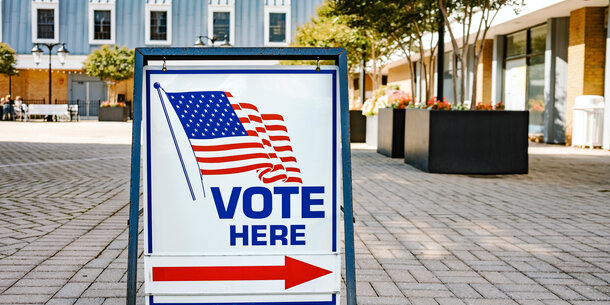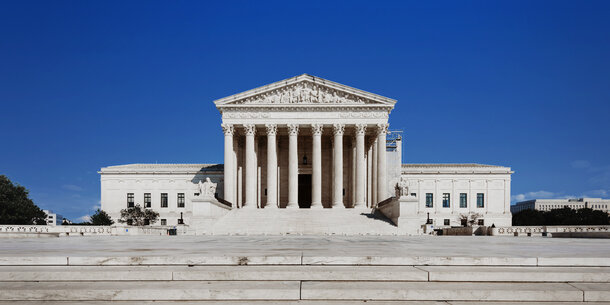The Department of Justice has long been charged with enforcing Section 2 of the Voting Rights Act of 1965, which protects voters when their rights are infringed on the basis of race or language-minority status. Despite this duty, the Trump DOJ has, in multiple cases, either dismissed its inherited affirmative Section 2 cases or changed its legal positioning to an anti-voter stance. It has become clear that voters can no longer look to the federal government to protect their right to vote.
Increased Scrutiny on Section 2 Cases
The DOJ is the sole governmental body charged with enforcing the Voting Rights Act nationwide, and its pullback comes at a time when Section 2 challenges are increasingly harder to bring.
Filing a lawsuit under Section 2 is one of the few substantive remedies for voters of color to repair the damage wrought by discriminatory policies. These can include challenges to election systems or redistricting schemes that prohibit voters of color from electing their preferred candidates, or voter suppression laws that could impact minority voters’ ability to register or cast a ballot.
In 2021’s Brnovich v. Democratic National Committee, the Supreme Court announced a difficult, novel test for plaintiffs challenging restrictive voting laws under Section 2. Additionally, conservative circuit court judges, state defendants, and even white private plaintiffs are chipping away at Section 2. Indeed, the Eighth Circuit Court of Appeals recently adopted the radical argument that private plaintiffs — such as voters — do not have a right to sue under Section 2. The Fifth Circuit Court of Appeals narrowed the scope of claims that plaintiffs can bring by finding that multiple groups of minority voters cannot form a coalition to bring a Section 2 claim to challenge an unfair redistricting plan or at-large method of election. And a case before the Supreme Court is set to decide the constitutionality of majority-minority districts in Louisiana, a remedy the state implemented in response to a court’s ruling that the prior maps likely violated Section 2.
In such a fraught Section 2 litigation landscape, the role of the United States as a public plaintiff enforcing Section 2 becomes critical. Under previous administrations — including President Trump’s first term — the DOJ continued to challenge violations of Section 2.
The DOJ Is Washing Its Hands of Its Inherited Caseload
At the start of this year, the Brennan Center identified 14 active Section 2 cases pending in federal courts where the United States was a party in the case, had filed a friend-of-the-court brief, had requested to participate in oral argument, or some combination of the three.
Since then, Attorney General Pam Bondi and Assistant Attorney General Harmeet Dhillon have signaled new priorities for the Voting Section. In April, the DOJ’s Civil Rights Division issued a new mission statement for the Voting Section, prioritizing the prevention and prosecution of so-called voter fraud rather than the affirmative protection of voting rights across the country. They also reassigned Voting Section career managers and instructed career voting rights attorneys to dismiss their active cases, leaving the future of federal Voting Rights Act enforcement murky at best.
As a result, the DOJ has now withdrawn its engagement in seven Section 2 voting cases: In four, it voluntarily dismissed cases it had previously brought; in one, it withdrew its statement of interest and dismissed its intervening lawsuit; in another, it withdrew its brief and rescinded its request to participate in oral argument as amicus; and finally, it withdrew a friend-of-the-court brief that was its only method of engagement. These cases consider a wide range of claims on behalf of voters, including local at-large election systems, a bifurcated state/federal voter registration form, restrictions on mail-in and early voting, discrimination in redistricting, and one constitutional challenge to a redistricting remedy enacted in response to Section 2 violations.
The below figure maps out states and Section 2 cases in which the DOJ has withdrawn its engagement since the start of the president’s term.
As for the remaining cases of the original 14, one, Merrill v. Milligan, has since been decided. The United States remains a party in three Section 2 cases and has filed friend-of-the-court briefs in another three. Of those, one is stayed pending resolution outside of court, three are pending a decision from the court, and two are ongoing.
Risks of Lack of DOJ Enforcement
The right to vote is at risk without the DOJ’s enforcement of Section 2. For example, in United States v. City of Hazleton, the United States challenged that city’s at-large election system, alleging that it denies Latino voters the opportunity to effectively participate in city council elections. The DOJ voluntarily dismissed the case in late April. So far, no private plaintiffs have stepped in to refile, and if that remains so, Latino voters in Hazleton may be unable to elect their preferred candidates in city council contests.
Fortunately, the remaining cases from which the federal government has rescinded its involvement are still being litigated by private plaintiffs — Black or Latino voters. But should the private plaintiffs not succeed, these voters may effectively be locked out of local elections, have their votes carry less weight in congressional or legislative races due to discriminatory maps, or otherwise continue to face serious barriers to exercising their right to vote. Any of these outcomes would leave these historically marginalized groups vulnerable to discrimination by governments and state officials that they have less power than their white counterparts to vote out.
And while most cases from which the DOJ has withdrawn involvement will continue, several are considering radical legal arguments that could further hamper Section 2 litigation — including arguments the DOJ previously sought to block. For example, in Callais v. Landry, a group of white plaintiffs argues that when the Louisiana State Legislature redrew its congressional districts as a remedy pursuant to Section 2, the newly drawn map violated the Equal Protection Clause because it disadvantages non-minority voters.
On behalf of the United States, the DOJ filed a friend-of-the-court brief in December 2024 in the Supreme Court case, arguing that there was a “strong basis in evidence” to believe that the legislature needed to draw the maps as it did. Just days after Trump’s second inauguration, however, the then–acting solicitor general withdrew both the DOJ’s brief and her predecessor’s request to participate in oral argument at the Supreme Court. It is a curious decision given that the solicitor general’s participation as amicus typically carries special weight with the Supreme Court, and reversing a position it has taken in past Supreme Court cases could adversely affect the department’s credibility. A ruling in favor of the Callais plaintiffs risks the Supreme Court finding that some of the most effective Section 2 remedies could be deemed unconstitutional because they seemingly violate the 14th Amendment. It would be an unprecedented, dangerous decision that would be binding on all federal courts.
The DOJ has withdrawn even when its participation is not critical. It withdrew its friend-of-the-court brief just six days before the Ninth Circuit Court of Appeals heard oral argument in Soto Palmer v. Hobbs over whether Washington’s legislative districts dilute Latinos’ voting power. Unlike most other withdrawals, the United States was not a party in this case, and its role as amicus would not have required further action from the department.
Regardless of its impact on the outcome of litigation, the DOJ is sending a clear message: It will not take positions to uphold the enforcement of the Voting Rights Act. With Section 2 already facing attacks on multiple fronts, this DOJ’s actions will further harm voters.
• • •
A DOJ that will not defend voters is doubly insidious when the Supreme Court has dismantled the Voting Rights Act’s preventive power to review discriminatory voting and representation policies in its Shelby County decision. Since 2013, voters have only been able to seek relief for racial discrimination in voting and representation in court after the fact. Often, relief comes after long bouts of litigation, and the harm to voters may have persisted all the while.
While a system that allows for the reversal but not prevention of racially discriminatory practices is by no means ideal, it works best when both voters as private plaintiffs and the federal government work together to challenge such policies — especially now when the Voting Rights Act’s adversaries seek to bar private plaintiffs from bringing Section 2 claims altogether.
Voters are at a crossroads. As we approach the Voting Rights Act’s 60th anniversary, we remember the promise of the federal government to eliminate racial discrimination in voting and to provide relief should bad actors attempt to bar voters of color from asserting their constitutional rights. This DOJ is subverting the intent of Congress, and instead of being a partner to voters, it has left them to fight alone.



